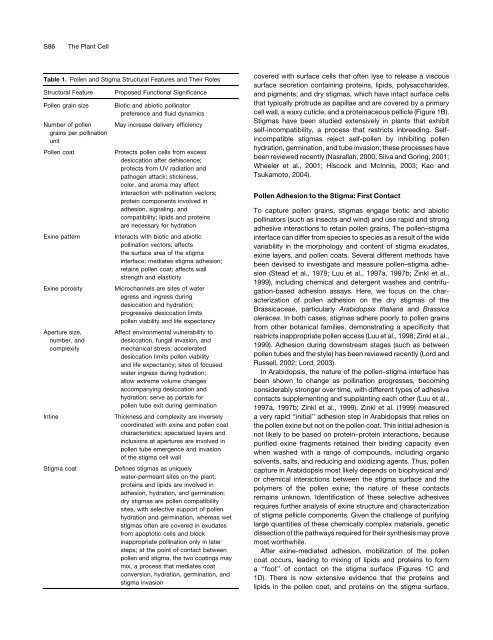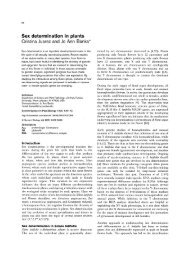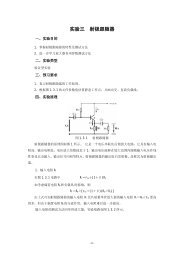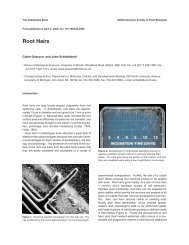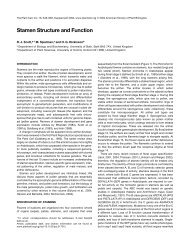Pollen and Stigma Structure and Function: The Role of Diversity in ...
Pollen and Stigma Structure and Function: The Role of Diversity in ...
Pollen and Stigma Structure and Function: The Role of Diversity in ...
You also want an ePaper? Increase the reach of your titles
YUMPU automatically turns print PDFs into web optimized ePapers that Google loves.
S86<br />
<strong>The</strong> Plant Cell<br />
Table 1. <strong>Pollen</strong> <strong>and</strong> <strong>Stigma</strong> Structural Features <strong>and</strong> <strong>The</strong>ir <strong>Role</strong>s<br />
Structural Feature<br />
<strong>Pollen</strong> gra<strong>in</strong> size<br />
Number <strong>of</strong> pollen<br />
gra<strong>in</strong>s per poll<strong>in</strong>ation<br />
unit<br />
<strong>Pollen</strong> coat<br />
Ex<strong>in</strong>e pattern<br />
Ex<strong>in</strong>e porosity<br />
Aperture size,<br />
number, <strong>and</strong><br />
complexity<br />
Int<strong>in</strong>e<br />
<strong>Stigma</strong> coat<br />
Proposed <strong>Function</strong>al Significance<br />
Biotic <strong>and</strong> abiotic poll<strong>in</strong>ator<br />
preference <strong>and</strong> fluid dynamics<br />
May <strong>in</strong>crease delivery efficiency<br />
Protects pollen cells from excess<br />
desiccation after dehiscence;<br />
protects from UV radiation <strong>and</strong><br />
pathogen attack; stick<strong>in</strong>ess,<br />
color, <strong>and</strong> aroma may affect<br />
<strong>in</strong>teraction with poll<strong>in</strong>ation vectors;<br />
prote<strong>in</strong> components <strong>in</strong>volved <strong>in</strong><br />
adhesion, signal<strong>in</strong>g, <strong>and</strong><br />
compatibility; lipids <strong>and</strong> prote<strong>in</strong>s<br />
are necessary for hydration<br />
Interacts with biotic <strong>and</strong> abiotic<br />
poll<strong>in</strong>ation vectors; affects<br />
the surface area <strong>of</strong> the stigma<br />
<strong>in</strong>terface; mediates stigma adhesion;<br />
reta<strong>in</strong>s pollen coat; affects wall<br />
strength <strong>and</strong> elasticity<br />
Microchannels are sites <strong>of</strong> water<br />
egress <strong>and</strong> <strong>in</strong>gress dur<strong>in</strong>g<br />
desiccation <strong>and</strong> hydration;<br />
progressive desiccation limits<br />
pollen viability <strong>and</strong> life expectancy<br />
Affect environmental vulnerability to<br />
desiccation, fungal <strong>in</strong>vasion, <strong>and</strong><br />
mechanical stress; accelerated<br />
desiccation limits pollen viability<br />
<strong>and</strong> life expectancy; sites <strong>of</strong> focused<br />
water <strong>in</strong>gress dur<strong>in</strong>g hydration;<br />
allow extreme volume changes<br />
accompany<strong>in</strong>g desiccation <strong>and</strong><br />
hydration; serve as portals for<br />
pollen tube exit dur<strong>in</strong>g germ<strong>in</strong>ation<br />
Thickness <strong>and</strong> complexity are <strong>in</strong>versely<br />
coord<strong>in</strong>ated with ex<strong>in</strong>e <strong>and</strong> pollen coat<br />
characteristics; specialized layers <strong>and</strong><br />
<strong>in</strong>clusions at apertures are <strong>in</strong>volved <strong>in</strong><br />
pollen tube emergence <strong>and</strong> <strong>in</strong>vasion<br />
<strong>of</strong> the stigma cell wall<br />
Def<strong>in</strong>es stigmas as uniquely<br />
water-permeant sites on the plant;<br />
prote<strong>in</strong>s <strong>and</strong> lipids are <strong>in</strong>volved <strong>in</strong><br />
adhesion, hydration, <strong>and</strong> germ<strong>in</strong>ation;<br />
dry stigmas are pollen compatibility<br />
sites, with selective support <strong>of</strong> pollen<br />
hydration <strong>and</strong> germ<strong>in</strong>ation, whereas wet<br />
stigmas <strong>of</strong>ten are covered <strong>in</strong> exudates<br />
from apoptotic cells <strong>and</strong> block<br />
<strong>in</strong>appropriate poll<strong>in</strong>ation only <strong>in</strong> later<br />
steps; at the po<strong>in</strong>t <strong>of</strong> contact between<br />
pollen <strong>and</strong> stigma, the two coat<strong>in</strong>gs may<br />
mix, a process that mediates coat<br />
conversion, hydration, germ<strong>in</strong>ation, <strong>and</strong><br />
stigma <strong>in</strong>vasion<br />
covered with surface cells that <strong>of</strong>ten lyse to release a viscous<br />
surface secretion conta<strong>in</strong><strong>in</strong>g prote<strong>in</strong>s, lipids, polysaccharides,<br />
<strong>and</strong> pigments; <strong>and</strong> dry stigmas, which have <strong>in</strong>tact surface cells<br />
that typically protrude as papillae <strong>and</strong> are covered by a primary<br />
cell wall, a waxy cuticle, <strong>and</strong> a prote<strong>in</strong>aceous pellicle (Figure 1B).<br />
<strong>Stigma</strong>s have been studied extensively <strong>in</strong> plants that exhibit<br />
self-<strong>in</strong>compatibility, a process that restricts <strong>in</strong>breed<strong>in</strong>g. Self<strong>in</strong>compatible<br />
stigmas reject self-pollen by <strong>in</strong>hibit<strong>in</strong>g pollen<br />
hydration, germ<strong>in</strong>ation, <strong>and</strong> tube <strong>in</strong>vasion; these processes have<br />
been reviewed recently (Nasrallah, 2000; Silva <strong>and</strong> Gor<strong>in</strong>g, 2001;<br />
Wheeler et al., 2001; Hiscock <strong>and</strong> McInnis, 2003; Kao <strong>and</strong><br />
Tsukamoto, 2004).<br />
<strong>Pollen</strong> Adhesion to the <strong>Stigma</strong>: First Contact<br />
To capture pollen gra<strong>in</strong>s, stigmas engage biotic <strong>and</strong> abiotic<br />
poll<strong>in</strong>ators (such as <strong>in</strong>sects <strong>and</strong> w<strong>in</strong>d) <strong>and</strong> use rapid <strong>and</strong> strong<br />
adhesive <strong>in</strong>teractions to reta<strong>in</strong> pollen gra<strong>in</strong>s. <strong>The</strong> pollen–stigma<br />
<strong>in</strong>terface can differ from species to species as a result <strong>of</strong> the wide<br />
variability <strong>in</strong> the morphology <strong>and</strong> content <strong>of</strong> stigma exudates,<br />
ex<strong>in</strong>e layers, <strong>and</strong> pollen coats. Several different methods have<br />
been devised to <strong>in</strong>vestigate <strong>and</strong> measure pollen–stigma adhesion<br />
(Stead et al., 1979; Luu et al., 1997a, 1997b; Z<strong>in</strong>kl et al.,<br />
1999), <strong>in</strong>clud<strong>in</strong>g chemical <strong>and</strong> detergent washes <strong>and</strong> centrifugation-based<br />
adhesion assays. Here, we focus on the characterization<br />
<strong>of</strong> pollen adhesion on the dry stigmas <strong>of</strong> the<br />
Brassicaceae, particularly Arabidopsis thaliana <strong>and</strong> Brassica<br />
oleracea. In both cases, stigmas adhere poorly to pollen gra<strong>in</strong>s<br />
from other botanical families, demonstrat<strong>in</strong>g a specificity that<br />
restricts <strong>in</strong>appropriate pollen access (Luu et al., 1998; Z<strong>in</strong>kl et al.,<br />
1999). Adhesion dur<strong>in</strong>g downstream stages (such as between<br />
pollen tubes <strong>and</strong> the style) has been reviewed recently (Lord <strong>and</strong><br />
Russell, 2002; Lord, 2003).<br />
In Arabidopsis, the nature <strong>of</strong> the pollen–stigma <strong>in</strong>terface has<br />
been shown to change as poll<strong>in</strong>ation progresses, becom<strong>in</strong>g<br />
considerably stronger over time, with different types <strong>of</strong> adhesive<br />
contacts supplement<strong>in</strong>g <strong>and</strong> supplant<strong>in</strong>g each other (Luu et al.,<br />
1997a, 1997b; Z<strong>in</strong>kl et al., 1999). Z<strong>in</strong>kl et al. (1999) measured<br />
a very rapid ‘‘<strong>in</strong>itial’’ adhesion step <strong>in</strong> Arabidopsis that relies on<br />
the pollen ex<strong>in</strong>e but not on the pollen coat. This <strong>in</strong>itial adhesion is<br />
not likely to be based on prote<strong>in</strong>–prote<strong>in</strong> <strong>in</strong>teractions, because<br />
purified ex<strong>in</strong>e fragments reta<strong>in</strong>ed their b<strong>in</strong>d<strong>in</strong>g capacity even<br />
when washed with a range <strong>of</strong> compounds, <strong>in</strong>clud<strong>in</strong>g organic<br />
solvents, salts, <strong>and</strong> reduc<strong>in</strong>g <strong>and</strong> oxidiz<strong>in</strong>g agents. Thus, pollen<br />
capture <strong>in</strong> Arabidopsis most likely depends on biophysical <strong>and</strong>/<br />
or chemical <strong>in</strong>teractions between the stigma surface <strong>and</strong> the<br />
polymers <strong>of</strong> the pollen ex<strong>in</strong>e; the nature <strong>of</strong> these contacts<br />
rema<strong>in</strong>s unknown. Identification <strong>of</strong> these selective adhesives<br />
requires further analysis <strong>of</strong> ex<strong>in</strong>e structure <strong>and</strong> characterization<br />
<strong>of</strong> stigma pellicle components. Given the challenge <strong>of</strong> purify<strong>in</strong>g<br />
large quantities <strong>of</strong> these chemically complex materials, genetic<br />
dissection <strong>of</strong> the pathways required for their synthesis may prove<br />
most worthwhile.<br />
After ex<strong>in</strong>e-mediated adhesion, mobilization <strong>of</strong> the pollen<br />
coat occurs, lead<strong>in</strong>g to mix<strong>in</strong>g <strong>of</strong> lipids <strong>and</strong> prote<strong>in</strong>s to form<br />
a ‘‘foot’’ <strong>of</strong> contact on the stigma surface (Figures 1C <strong>and</strong><br />
1D). <strong>The</strong>re is now extensive evidence that the prote<strong>in</strong>s <strong>and</strong><br />
lipids <strong>in</strong> the pollen coat, <strong>and</strong> prote<strong>in</strong>s on the stigma surface,


